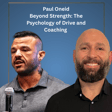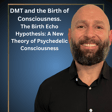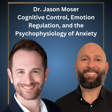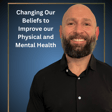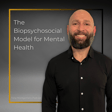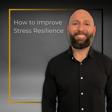Become a Creator today!Start creating today - Share your story with the world!
Start for free
00:00:00
00:00:01

Emotions, Feelings, and How to Regulate Them
In this episode I discuss the science behind how emotions are made. The difference between emotions and feelings and why that is an important distinction to make. I also talk about effective strategies on how to regulate emotions, cope with stress, and shift one's perspective and beliefs towards stress to improve the nervous system response.
Transcript
The Nature of Emotions
00:00:01
Tony Montgomery
In today's episode, we're going to go over emotions, feelings, and emotion regulation. There's a wide breadth of knowledge and research on emotions, and there's still a lot of controversy behind the general consensus of of what emotions are.
00:00:20
Tony Montgomery
how they operate within our body. Are they universal or are they constructed? Are they something that is malleable? just kind of what the definitions of those things are and and how they play a role in mental health, human behavior, and the things that help us deal with day-to-day interactions.
00:00:40
Tony Montgomery
I think it's first important to go over the ideas and key terminologies of of what emotions are, what feelings are, and we'll go into the idea of of how can we regulate them on a consistent basis to help us with mental health and our day-to-day interactions the people that we that we that we come across.
Physiological Responses and Homeostasis
00:01:00
Tony Montgomery
so What is an emotion? Emotions are action-oriented physiological responses to stimuli that arise from the brain's interaction with the body to maintain homeostatic regulation. right So I think the key here is that they are physiological responses that are something to do with homeostatic regulation. right And I think one of the biggest issues we have with the research on emotions is not so much
00:01:31
Tony Montgomery
kind of what the research shows us, but the definitions used to describe what emotions are. And you'll hear those definitions with terms such as fear, sadness, anger. Those are kind of the basic emotions that we'll go over later on in the discussion. But one of the key things we want to focus on is the idea that emotions are physiological responses first and foremost.
Predictive Models of Emotion
00:01:57
Tony Montgomery
So we don't want to necessarily give them a label or or a name. I think within the research, we have a tendency to to do that. And I think that it's great in some senses where the the more we can label something, the more that we can pinpoint the research and and dive into it. it also kind of pigeonholes us and it creates a lot of
00:02:20
Tony Montgomery
internal dialogue that's messy, right? So I think if understanding this idea that emotions are these physiological responses to a stimuli and not necessarily put a word on it, if we do want to put a word on it, it's I would say that there are predictions of uncertainty and certainty. I think that can be, when you look at the research, I think when we think about universal responses, which have a lot of controversy behind them, whether or not our emotions are universally ingrained in us,
00:02:54
Tony Montgomery
or are they something that develop over time? I think you can get rid of that messiness by just saying that they are predictions of uncertainty and certainty based on our perceptions of the world around us and our internal states, right? So in order for us to continue to regulate our homeostasis, our homeostatic environment, we have to continue to make predictions of certainty such as being in a safe, happy environment So that's going to predict a certain physiological response, such as warmth, low anxiety, low stress, or uncertainty, meaning that could be something along the lines of the
00:03:36
Tony Montgomery
The thing that we always hear about, right? The see a snake, we get the startled response. Our sympathetic nervous system goes into activation. We get a increased heart rate. We have a increased increased sweat response in order for us to continue to strive forward and either fight or flight.
00:03:57
Tony Montgomery
right So I think if we understand that these are the physiological responses, get away from fear, get away from anger, I think we can better conceptualize the idea of what emotions
Homeostasis, Allostasis, and Stress Management
00:04:07
Tony Montgomery
are. right So in order for us to dive in a little bit deeper to that idea, we need to first go over this idea of what homeostasis is. right And that refers to the body's process to maintain internal stability and equilibrium, ensuring the physiological functions remain within a narrow and optimal range despite the changes that occur outside of us, right? So within the context of emotions, homeostatic regulation involves the body's autonomic and adaptive responses to internal emotional states, ensuring emotional balance,
00:04:43
Tony Montgomery
Right? So these body signals, these emotional responses can act as signals for the body to return to homeostasis. A good example of that could be the feelings that a stressful situation might trigger a physiological response, physiological logical change, increased heart rate, hormone release, such as cortisol, which activates glucose, which gets us ready to pursue or run away from and prepares the body to address the perceived threat. Once that threat is addressed, the body seeks to return to a baseline emotionally and physiologically maintaining that equilibrium. right The emotional responses such as sadness and anxiety can be seen as internal signals that prompt action and to restore balance.
00:05:30
Tony Montgomery
Within homeostasis, right, that's the idea that we have this emotional equilibrium. We also have allostatic load and allostasis. I think Lisa Feldman Barrett summarizes this idea beautifully in her book, How Emotions Are Made, that elaborates on a lot of the topics that we're discussing today. And she talks about this idea that we have a body budget.
00:05:54
Tony Montgomery
and when we're doing stressful events especially chronically stressful events that can continue to make withdrawals of our body budget and then every time we do something say exercise or meditation or interact with a friend that can improve our body budget that can put deposits in. So that's a great way to think of allostasis and allostatic load. ah key definition here is allostasis refers to the process by which the body adapts to stress and other environmental demands through change in physiological systems to achieve stability. Unlike homeostasis, which is about maintaining stable conditions, allostasis is about achieving stability through change, right?
Chronic Stress and Health Impacts
00:06:39
Tony Montgomery
That's where we come in with those putting things in, taking things out.
00:06:44
Tony Montgomery
the allostatic load refers to the cumulative wear and tear on the body and brain resulting from chronic stress or repeated activation of the body's adaptive system. So we want to make sure that we understand fundamentally that it's chronic stress, that not all stress is bad. There's good stress and there's bad stress. The bad stress seems to be when it becomes chronic in nature and that is going to be perceived through a maybe a continuous fight with a close relative or a loved one.
00:07:13
Tony Montgomery
It could also be continuing to train hard and pushing your body. and Those are chronic stress environments along with poor sleep, poor food. All those things can add up to create this chronic stress, whereas an acute bout of exercise or an acute fight that gets resolved afterwards, those are gonna be more or less those acute stresses that are actually beneficial to the body. Those are putting things back in to that body budget.
00:07:41
Tony Montgomery
So over time, this load can lead to negative health consequences, including weakened immune function, which we've all seen from time to time with the idea that in highly stressed situations, our body's very adaptive to fighting off that stressful response. Our immune system comes into play to help ward off any any type of disease, any type of bacteria, any type of infection, so that we're able to make it through that stressful situation. And then all of a sudden, once that stress is resolved, the immune system needs to take a break.
00:08:10
Tony Montgomery
It becomes bogged down and that's typically when we get sick right after those stressful events, those stressful situations. So that's the way we want to look at allostatic load.
Managing Emotional Dysregulation
00:08:19
Tony Montgomery
Chronic emotional stress such as prolonged anxiety, anger, or sadness can contribute to increased allostatic load, negative emotions that are very persistent. We want to make sure that they get resolved. The more they're unresolved, ah the more we start to pull from that body budget. And then emotional dysregulation, that's the inability to manage emotions, which we'll talk about when we talk about emotion regulation.
00:08:42
Tony Montgomery
Our ability to manage those emotions and get positive outcomes from them is often associated with lower allostatic load, dysregulation, higher allostatic load. This could occur when individuals are unable to return to baseline emotional states.
00:08:58
Tony Montgomery
So a good example of this would be say that you are in a fight with a a loved one and you still train every day. Say you run in, right? And then you'll notice as you run and in those high chronically elevated stressful situations of fighting, you'll notice that you'll start to, the runs will become a little bit more difficult. You'll start to feel a little bit more worn down. And then all of a sudden once that fight becomes resolved and there's this idea of emotional relief,
00:09:27
Tony Montgomery
you'll notice the next day and the following day that those runs all of a sudden become more energetic, even though you haven't changed necessarily your sleep, although fighting an emotional dysregulation can affect your sleep. But you'll notice that like, man, all of a sudden I still i feel a lot better and I'm able to push this run, even though really nothing's changed except for that
Movement, Learning, and Emotion
00:09:48
Tony Montgomery
emotional state. So that's the thing that we want to think about when it comes to allostatic load, homeostasis, and our ability to to regulate
00:09:58
Tony Montgomery
So two of the most metabolically demanding things that are that we can do as human beings, the two most disruptive things, when we think about metabolically demanding, we're also thinking about disruption towards homeostasis is movement and learning, right? Movement and learning play dynamic roles in emotion as well. And we'll discuss those later on as we get into emotional regulation strategies.
00:10:20
Tony Montgomery
i' Emotions are not only the key to guide in behavior, but also play a central role in the development of a a sense of self. And this is something that neuroscientist Antonio Damasio talks about, that you have as single cell organisms we evolved from, was always this idea of of sense and then respond. And the idea of sense and respond was into survival, to feed, to replenish the body.
00:10:48
Tony Montgomery
And as we developed into multicellular organisms, that became these physiological responses towards uncertainty or certainty which eventually became emotions and eventually developed with the nervous system.
00:11:03
Tony Montgomery
So one of Antonio Damasio's theories is that consciousness was preceded by emotions and feelings, that we had to have emotions and feelings first before we become aware of of who we are, this interceptive self. And that's something that I think we can easily wrap our minds around once we understand the evolution of a human being and coming from single cell organisms to multicellular and how we've adapted and and overcame. So that tells you fundamentally how important emotions and influence are to the the human mind and the human body.
00:11:42
Tony Montgomery
They're not separate for reason, but integral to it. And the body's physiological responses, such as changes in heart rate or sweat and help inform the brain about the state of the body and the external environment guiding in adaptive ways.
Constructed Emotions Theory
00:11:55
Tony Montgomery
Within the research, one of the things we measure is from an objective standpoint is heart rate and skin conductance.
00:12:03
Tony Montgomery
And then subjectively, we look at things like questionnaires and just that human experience. Those are all things that we look at within the research to kind of parse out this idea of of what emotions are and and how we can study them. Before we get into more of the emotion, I think it's it's important to define what what feelings are because they are separate entities.
00:12:24
Tony Montgomery
And again, talking about Antonio Damasio here, he states that feelings are subjective experiences of emotions, right? It's the perception of that emotional state. While emotions are bodily responses, feelings are the conscious preparation of those emotional states, right? Feelings arise when the brain processes the emotional response and given rise to awareness and interpretation of the bodily state. ah ah He also posits that the brain creates an ongoing map of the body state, which is essential for both emotions and feelings. This process helps maintain homeostasis, the internal balance, and is crucial for survival. The brain's capacity to produce a coherent sense of self arises from the integration of emotions, bodily sensations, and that environmental context.
00:13:12
Tony Montgomery
And then another key figure in the neuroscience of emotions. And we touched about her book, How Emotions Are Made, Lisa Feldman Barrett. She talks about this core effect as a foundational component of emotions.
00:13:27
Tony Montgomery
And it refers to the fundamental underlying of feeling states like pleasure versus displeasure, arousal versus calm. Those core affective states are always present, right? Though not always consciously recognized, the brain combines core affect with sensory input, memories, and cultural context to construct specific emotions.
00:13:47
Tony Montgomery
So that's the key thing here, right? The brain combines core a effect with sensory input, memories, and cultural context to construct specific emotions. So we talked about this idea fundamentally of maybe universal constructs of these physiological responses due to senses and responding that served us well when we were evolving from single cell to multicellular organisms. But I think as we've adapted and and we've evolved, we've also created sensory input memories, cultural context, like all these things grow and expand.
00:14:22
Tony Montgomery
that continue to refine our feeling states, that refine how we express and how we understand the physiological, the emotions that we have.
00:14:34
Tony Montgomery
Lisa also believes that the emotions and feelings are constructed, which will go into this constructionist theory a little bit later, that these experiences and feelings are not just passive, but are shaped by the brain's predictions and conceptualizations, right? affect is used and we're just trying to define these terms as the best we can so that I think one of the key things when it comes to emotion, emotional intelligence, emotion regulation is to improve our vocabulary
00:15:03
Tony Montgomery
of what these things mean and how we can define them. I think the more we can get into the weeds of building a vocabulary around emotion, the more we can help regulate them. So that's kind of why we're taking the time to go over these definitions and and get into some of the more nuances of emotions and and feelings.
00:15:23
Tony Montgomery
Affect is used to refer to the experiential or behavioral components of emotion. Affect is the superordinate category for a valence state. So you have positive valence, you have negative valence, including emotions such as anger and sadness. I would i would say that those are those are more feelings. And then the emotional state that comes from those to be expressed.
00:15:45
Tony Montgomery
So think of it as a valence date would be that you're you're exercising and you're doing a very hard conditioning workout, right? You may have during that workout a negative valence towards exercise because it's brutal. You're out of breath and you just want it to be done. But then when you're done with it, you're going to have that sense of accomplishment. So then you're going to have more of a positive valence towards exercise afterwards. And we'll talk about exercise and the role that it plays.
00:16:14
Tony Montgomery
in mental health in another episode, but just kind of give you an idea of an example of of what that could look like. So within the A Effect family, we have things like emotion, emotion episodes, and mood. Emotions unfold over a relatively short period. Emotion episodes are more extended in both time and space. They're also referred to as plots, scripts, adaptational encounters, include each of the protagonists and all the events in a given emotional scene.
00:16:42
Tony Montgomery
For example, the emotion of anger. Anger can be something that has a physiological response of flushing of the face, increased heart rate, sweat, resir respiration, right? All those things can be something that is a physiological state of anger, involves acute changes in posture, facial movements, tone, or voice, verbal expression, experience, and automatic autonomic respondents.
00:17:11
Tony Montgomery
The emotion episode includes all these things as well as the instigator, the person who's making you angry, the social context of where this anger has taken place. Is it taking place where you're alone or is it taking place where you're in the comfort of your friends? That's gonna affect how you feel about that emotional state and the whole sequence of responses and ah recriminations as they emerge in the ongoing interaction. So those are emotion episodes.
00:17:40
Tony Montgomery
We can also think about moods, which we touched on, and the distinguishing feature is the duration. A mood such as depression or anxiety, those are those are mood states.
00:17:52
Tony Montgomery
They're pervasive and sustained through an emotional climate. Emotions are fluctuating changes within emotional weather is one way to look at it. a Second distinguishing feature is that emotions typically have specific objects and give rise to behavioral responses and tendencies relevant to these objects.
00:18:10
Tony Montgomery
by contrast, moods are more diuse diffuse and although they may give rise to broad action, tendencies such as approach or withdrawal, moods bias cognition more than they bias action. So when you're thinking about somebody that suffers from depression, that's more of a cognitive state because we do know that things such as memory, rumination, and and a lot of other things go into what makes somebody in a depressed mood, whereas Emotions again are those physiological responses that bias action towards towards something or away from something So there's three theories on how emotions are made within these three theories two of them have a lot of good
00:18:55
Tony Montgomery
neuroimaging data on it and those are the two that we'll focus on the most.
Universal Emotions and Facial Expressions
00:18:59
Tony Montgomery
The first one is this basic emotion theory by Paul Ekman and Carol Isard, proposes this idea that emotions are hardwired and basic emotions which we've we've all seen if we've taken any psychology classes is fear, anger, sadness, enjoyment, contempt, surprise, disgust,
00:19:19
Tony Montgomery
And the way that they categorize those within the context of learning environments is they use these pictures of faces that express universal acceptance of this is the emotion of happiness with a smile, ah ah the emotion of anger with a a burrowed brow and a flushed face, right a snarl, so to speak. and And so they propose this idea that these emotions are are hardwired and they're ingrained and they're universal across the world, that everyone can recognize them, everyone understands them, and they can be expressed through facial expressions. right
00:20:01
Tony Montgomery
According to this perspective, emotions are largely innate, arising directly from certain stimuli and manifesting itself in predictable ways across cultures. Some believe these actions are automatic and universal while others disagree. they So so why why within the research do we think that these things could be automatic? Some of the stuff that they've shown within their own research was shown a bunch of faces to people and seeing if they can categorize those faces. And a lot of times with certain contexts,
00:20:37
Tony Montgomery
they they can and even without context they can as well but then when you go to different cultures we see that those contexts no longer are representative of their ability to distinguish what those emotions are but another way to think about it is this predetermined set of reactions that our body has. So when you look at the social biases research, we know that regardless of ethnicity, when we see a darker skin tone, we have an amygdala response, which has a lot of links towards fear. right So this is an automatic response
00:21:22
Tony Montgomery
when you think about consciousness, when you think about free will, determinism, we have a lot of automatic responses. We are inundated as a conscious species with over a million bits per second, if you think from a computer perspective. Within those bits, within those millions of bits, we're only able to actually consciously process between 15 to 30 bits So there's a lot of unconscious stimulus that we're receiving. Within that research, they've shown that we have these fundamental actions that happen within the brain. And then once those actions happen, there's about a half a second for us to react to those reactions. So that gives us that half a second of free will, so to speak, right? So we're able to say, feel these emotions, this amygdala response of darker skin tone
00:22:13
Tony Montgomery
And then we're able to in that half second accept it and either fight or or flight or to reject it and say, we're in a safe environment. I know this person. So therefore, but that that predisposition to have those actions happen first is something that these basic emotion theories rely on from the research perspective to why these things might be automatic in in nature.
00:22:42
Tony Montgomery
So the next one that we're gonna talk about that doesn't have a ton of neuroscience or a ton of neuroimaging data to kind of back it up are these appraisal theories, which are represented by most of the, a lot of the research is by Richard Lazarus and Klaus Scherer. Emotions result from an individual's interpretation or appraisal of a situation. he Emphasizes ah ah the cognitive evaluation of events.
00:23:10
Tony Montgomery
And emotional expressions are not seen as fixed reflexes, but fluid products of cognitive processes. Once we get into emotion regulation and the role that that can play in helping us understand, we'll see the appraisal effect come into full force there. But again, within the idea of how emotions are created, this is very much of a process that is beyond the physiological responses, not preemptively to them, not within them.
00:23:39
Tony Montgomery
but it's something that we can use to help develop the way we cope with them and the way we fluctuate with them. And then the thing that we touched on previously, the theory of constructed emotion, and this is the research that's done by Lisa Feldman Barrett and her her
Emotions and Past Experiences
00:23:55
Tony Montgomery
colleagues. It argues that emotions are not fixed, universal modules hardwired at birth, but instead they are constructed in the moment by integrating core effect, basic feelings of pleasure, displeasure,
00:24:09
Tony Montgomery
contextual information, language, which we talked about, and and culture. right The brain does not simply detect an emotion. It actively uses past experiences and conceptual knowledge to predict and categorize bodily sensations and the external events as an emotion. And we know that that's how memory works as well. It's this big prediction error machine. right So every time we have this prediction scheme that we develop from birth and and beyond,
00:24:36
Tony Montgomery
And the idea with that prediction scheme is that every time something happens, we have this idea of what should take place based on previous experiences. And then every time an error occurs, we update that prediction so that future instances were able to have a different representation of what this experience could be based on the past experiences, based on the environment that we're in. right So we have all this information coming in through our senses, through our previous experiences that help to form these these feelings and these these emotional states and how we how we deal with these emotional states. So as you can see that this model
00:25:17
Tony Montgomery
is very much in line with the neuroscience research, in line with memories, in line with with a lot of conceptual ideas that that make a ton of sense. But there's also some evidence to show that the idea that these physiological states that these emotions project could be something that is innate within us.
00:25:39
Tony Montgomery
in utero. It could be something that this idea that we hear talked about a lot of times, um although it's come under some scrutiny as of late, so the research needs to be a little bit more in depth to get a true response, is the idea that we can pass on trauma, right? That we have these trauma responses that we can pass from generation to generation. That gets talked about a lot, even though it's come under a lot of scrutiny lately. And I think the key thing we want to take away from that is I think as as human beings evolved, we have these natural instincts to protect us from the environment. And I think those are are universally ingrained. And when I say universally ingrained, i feel I want to say that they are physiological responses based on the world that we're raised in. We know that
00:26:31
Tony Montgomery
mothers that are in high stress situations in utero duringn during the burden period through the TriMasters that they with high stressful situations, chronic stress, cortisol, HPA access, all these regulation systems that we have, as they start to get dysregulated, we've seen research showing that the babies that come out of high stressful situations have enlarged amygdala, so they have a ah ah more heightened sense of fear, a fear response, so to speak, and then smaller prefrontal cortexes, so their ability to make decisions is blunted.
00:27:12
Tony Montgomery
right That's ingrained at birth due to the environment. and and So we do come out of utero with a lot of things built into us. Also touching upon Carl Jung's idea of this unconscious collective, right? These things that are passed down through time. I think there's good research on that. I think there's good theory on that. And it's something that I tend to resonate with and and lean my hat on based on what I've read is that There are a lot of universal things that get passed down as protective mechanisms to make sure that we survive in harsh conditions. And I think what Lisa Barrett here is talking about is
00:27:57
Tony Montgomery
the idea that as ah ah soon and even within utero that we're getting a lot of information and we're continuing to turn out these ideas of fearful states and how to respond to them. Am I protected? Right. we We get all this stuff from from birth until we're adults and we're continuing to reflect upon those things. We're continuing to build our prediction error machines, which we we call the brain.
00:28:27
Tony Montgomery
And we're able to process this over and over again with the information that we get.
Brain Regions in Emotion Regulation
00:28:32
Tony Montgomery
A good example of this is right this idea that happiness is one of these universal emotions that has a lot of research on it that tends to universally be something that people can agree upon that, hey, a smiley face is.
00:28:51
Tony Montgomery
and emotion, a facial recognition of happiness, right? So an example would be, you know, say that you're you're walking down the street and you see somebody walk past you and they smile at you. Typically you're going to look at that and and say, okay, I don't have fear. There's certainty in this person. They're smiling. So therefore I perceive them as being happy and being in a good mood and non-threatening, right?
00:29:18
Tony Montgomery
but then say you walk to the next person and they're dressed like the Joker and they're smiling at you in this very weird psychotic type of smile, but it reflects, you know, a smile nonetheless, right? That context that we're receiving of the smile tells us that man, this might be threatening. Uh, let me get a physiological response of fear instead of happiness. And let me think about, should I fight?
00:29:47
Tony Montgomery
Or should I flee? Now, if you have 10 years of MMA experience and practice, right you may have a bigger desire to fight. You may feel safer in that situation due to your past experiences. If you have no background in that, you may think, I got to get the hell out of here. Something bad's about to happen. So then you flee. But then you realize,
00:30:13
Tony Montgomery
Oh, it's Halloween. This person's dressed as the Joker for Halloween and the smile is again reflective of happiness, right? Within that example, you can see the flexibility with this idea of universality and how context is the most important thing for creating feelings to emotional responses. And I think that's the biggest thing we want to get from this idea of emotions and and feelings is due to the language that we know. do know that there's other cultures that use words that don't translate into English dictionary. So they'll have more emotional attunement to certain things. in In Germany, there's a word for somebody that has a very punchable face, right? In English, we know when we see that person that has a very punchable face,
00:31:09
Tony Montgomery
And we get this feeling of like, man, I really want to punch this person. But in Germany, they have a word to describe that. and So the more we can understand and and create definitions of feelings, the more we can learn to regulate those emotional responses. The more we practice self-defense, the more we can regulate fear.
00:31:31
Tony Montgomery
the more we practice gratitude, the more we can regulate sadness. right So I think understanding those things is is vitally important. And then within culture, we know that human beings or nervous systems regulate themselves. So if we're around somebody in America, if we're around somebody who ah ah suppresses their emotions,
00:31:54
Tony Montgomery
That's going to create a negative nervous system response. And therefore, a lot of times as Americans, we suppress our emotions because emotional suppression is something that's perceived as negative within the culture of America. But in Chinese cultures, suppression is deemed as a a good thing.
00:32:14
Tony Montgomery
So within the research, we've seen that whenever two people are suppressing emotions in that context, that there's not a negative interaction with their nervous systems. They don't have this huge stress cortisol spike that we've seen in American culture. So we do know that culture plays a huge role. And that's why I tend to believe that the research that we're seeing showcases that there's not universality within certain brain areas, not universality within certain cultures. There's not universality within emotions. And I think that as we continue to proceed through this talk that you'll so you'll probably tend to agree with that as well.
00:33:03
Tony Montgomery
So the current state of the field, ah ah researchers generally agree that emotions evolve interactions among biological processes. ah ah Cognitive appraisals learn concepts and social norms in cultural contexts. There is still debate over whether certain emotions are universal or whether all emotion categories are socially constructed.
00:33:22
Tony Montgomery
Within research, you'll find a lot of debates happen in due to people build careers off of certain research. And when your careers are built off of that, it's very hard for people to admit when they're wrong or say that they're wrong.
00:33:36
Tony Montgomery
And you'll notice that the best researchers do that. There's neuroscientific evidence that shows that no single brain center, there's no single brain area for each emotion exists, although there's still a lot of research and pushback for this idea that we have these localized brain areas where emotions exist. and And we'll go into that and in just a second. So the field's moving away from a strict nature versus nurture stance to a more integrative view Biological dispositions interact with personal history, situational factors, cultural knowledge to shape emotional experiences. So what does the neuroscience show? Neuroimaging brain areas relevant to emotion. there's These areas are highly interconnected and emotions arise through complex interactions between several brain regions.
00:34:29
Tony Montgomery
They help process, regulate, and modulate emotional experiences based on both external stimuli and internal states. ah ah So some areas that we're going to focus on is the amygdala. Process is emotional stimuli, especially fear. The prefrontal cortex regulates emotions, allows for cognitive appraisals and emotional control. The insula processes bodily sensation, gives us that intraceptive sense of self, and that's tied to emotions.
00:34:57
Tony Montgomery
The anterior cingulate cortex handles emotional conflict and pain. And then meanwhile, regions like the hippocampus store emotional memories. The hypothalamus governs physiological responses. And the basal ganglia and the ventral tegmental area, BTA for short, handle reward motivation. Those are like the dopamine circuits, the neurotransmitters that are involved with reward and motivation. So the amygdala, which we hear about a ton and is one of the ideas that the the localized area of the amygdala is for for fear and why that could be fear and anxiety and and why a lot of people tend to to believe that is of the research does point to that idea, but I think
00:35:43
Tony Montgomery
With understanding that idea that we can turn on and off research done by Dr. Karl Dizeroff at Stanford, ah did optogenetics where they were able to look at individual neurons ah within the brain in the amygdala and they were able to either inhibit or excite in these in these mice and what they found was when they were able to excite these areas in the amygdala, a bunch of different areas, they were able to see a blunted anxiety response, right?
00:36:54
Tony Montgomery
um
00:36:56
Tony Montgomery
freely going around these open areas where typically they would be afraid of it or they hid in fear. so So that kind of points to the idea that there is some localization to this area but we know based on the research that the amygdala, like I talked about, does interact with the prefrontal cortex.
00:37:15
Tony Montgomery
and we have these white matter tracks that connect. And the research shows through exercise that these tracks get more solidified, they get stronger and stronger, and the stronger they get, the less fear reaction they have, and the better they are able to understand and make emotional decisions based on that. So we do know that there's this constant interaction between these brain areas.
00:37:41
Tony Montgomery
So some of the key functions of the amygdala is that it's responsible for fear recognition and the initiation of fear responses. It helps create emotion memory formation. And it particularly for negative emotions and emotion regulation and interaction with other brain areas, that's where the prefrontal cortex comes in. And touching on that prefrontal cortex, particularly the ventral medial prefrontal cortex and the dorsolateral prefrontal cortex play a key role in emotion regulation, decision making and cognitive appraisal of emotions. That cognitive appraisal piece, the ability to
00:38:16
Tony Montgomery
change the way we see emotions. That's a key role in the prefrontal cortex, ability to understand this is what happened. We can change. We can react. and That's what the prefrontal cortex is is known for. So it inhibits or modulates emotions. Its key function could be for empathy and moral decision making, which is why we see that in violent criminals.
00:38:41
Tony Montgomery
They tend to have a enlarged amygdala and a smaller prefrontal cortex. So their ability to have empathy and create moral decisions is lessened. And their fear their heightened fear response, their heightened anxious response is heightened, is more elaborate, right? So the insula.
00:39:01
Tony Montgomery
The insular cortex that is involved in interception that sense of self Which is a perception of internal bodily states and plays a significant role in emotional awareness and emotional feelings it's Helps with empathy recognizing others emotions Integrate in sensory information with emotional feelings. So that's connected to the hypothalamus these sensory information signals the anterior singular cortex and It's involved in emotional regulation, cognitive control, conflict resolution, plays a key role in processing emotional pain and social pain, such as social exclusion or rejection. It helps with both physical and emotional pain processing, again, plays a key role in empathy and decision-making in the emotional context, and is really good in emotional conflict detection.
00:39:53
Tony Montgomery
So when the emotions responses conflict with rational behavior, that's when we tend to see the anterior cingulate cortex light up. The hippocampus plays a, its primary role is for memory formation, but it's also involved in the emotional process and especially the formation of emotional-laden memories, which connects intricately with the amygdala. And that's where we start to get these emotional memories of fear. It also plays significant roles with emotional memories of depression. One of the key things that we know of is that we're if if we're able to improve a patient's memory in a positive manner it comes to patients with depression,
00:40:34
Tony Montgomery
that they're able to pull themselves out of depression because most of the memories that depressed people have are negative in nature. Then they create this rumination effect that continues to see things in a negative light. So we know that by introducing positive memories and creating these positive prediction error making, so we continue to create positive errors.
00:40:55
Tony Montgomery
It continues to update its prediction. That can help pull people out of depressive states. So we know the memory plays a a huge role when it comes to emotions. And in the more we can update that memory, the more we can understand if this is ah ah a safe environment, if we have a lot of certainty within this environment, or if we have a lot of uncertainty in this environment, and then how should we react to those things.
00:41:17
Tony Montgomery
The hypothalamus, it's critical for physiological expression of emotions. It controls the autonomic nervous system which regulates physiological responses such as heart rate breathing and hormonal release.
00:41:30
Tony Montgomery
The hormonal regulations such as cortisol, adrenaline, and those are all things that play important factors in fight or flight, chronic versus acute stress, and and how we continue to move from day-to-day interactions. Basic drives such as hunger, thirst, reproductive behavior, these are also influenced by emotional states that play a role within the hypothalamus. The basal ganglia, and particularly the Ventral striatum is involved in the reward process and motivation system. So think about that. This is where dopamine and the dopamine neurotransmitter is released within the brain towards the reward process and and motivation. It's key for emotional learning. And we see that people that are in depressed states or high anxiety states have lower levels of dopamine within within their brain structures.
00:42:23
Tony Montgomery
So the thalamus is the next one, and that's kind of the the relay station for sensory information. and And it plays a significant role in processing emotional responses to sensory stimuli. And it's it's great for sensory gait in for emotional stimuli, and it projects to the cortical regions involving emotional processing.
00:42:44
Tony Montgomery
Then we have the VTA, the ventral tegmental area. Again, that's part of the dopamine system, motivation, pleasure, reward. It's key functions is the the dopamine release related to emotional but motivational states. And it has this reward reinforcement learning dichotomy that it goes into. um So think of it in terms of kind of like the behavioral responses of reward, reinforce, reward, reinforce. And then again, if that's dysregulated, so every time we exercise, we feel the sense of joy. We feel the sense of mental clarity and physical health. So we reinforce that learning. So we continue to do it.
00:43:25
Tony Montgomery
But people that suffer with depression, mental health issues, they have more of a negative reward system. So it kind of feeds into that negative feedback loop and of rumination. And that's why it's very hard for people that suffer from these mental health disorders to get out of those dead states. So again,
00:43:45
Tony Montgomery
thinking about this idea to reinforce that there's so much interconnection of these brain areas. We have bottom-up and top-down processes. And so this paper that was published by auctioneer in 2009 explores how emotions are generated through the two primary processes. So you have the bottom-up process, which is perceptual.
00:44:09
Tony Montgomery
Kind of think like these automatic responses and they have the top down, which is more the cognitive the ability to make decisions and they use fMRI to study these responses and they found that amygdala activation. Both processes activate the amygdala, but bottom-up processing leads to stronger activation. So that immediate response is going to have stronger amygdala activation, right? And I think we're well aware of that when it comes to this idea of it needs to respond super fast so that we can either fight or flight.
00:44:40
Tony Montgomery
But there are distinct neural pathways. Bottom-up responses involve regions associated with sensory processing and intentional networks, while top-down engages regions involved in cognitive control and in interpretation. ah ah Activity in the amygdala correlates with self-reported emotions during bottom-up processing, while activity in the medial prefrontal cortex correlates with top-down processing, supporting the idea that different brain areas, different brain regions, are involved in each process.
00:45:10
Tony Montgomery
So that kind of goes to show that there's a wide interaction within the brain and there's plenty of research to to back that up. So I think we've clearly defined this idea of of emotions and and feelings, and we've given a lot of insight into that.
Emotion Regulation Processes
00:45:27
Tony Montgomery
But now we want to get into this idea of of how can we how can we regulate those? How can we see the mental health crisis that's going on in America and and really across the world? How can we better
00:45:41
Tony Montgomery
create tools to better understand and to get out of those situations. ah One of the key researchers in this area, James Gross, defines emotion regulation as the set of processes by which individuals influence which emotions they have, when they have them, and how they experience and express them. Emotional regulatory processes, they can be automatic or controlled, conscious or unconscious, and may have their effects at one or more points in the emotion generative process.
00:46:11
Tony Montgomery
So he views these emotional responses as tendencies towards behavioral, experiential, physiological changes that occur in response to significant situations and highlights that emotion regulation operates on these tendencies.
00:46:29
Tony Montgomery
defines this process as occurring at five points in the emotion generative process. So we have situation selection, situation modification, attention deployment, cognitive change, and response modulation. And we'll get into those five areas and how we can use those as a tools to to regulate our emotions.
00:46:51
Tony Montgomery
So the idea of emotional sensitivity and conceptualizing emotion regulation as a process that determines the offset of emotional responses, unlike emotional sensitivity, emotional regulation,
00:47:07
Tony Montgomery
can help influence their onset. right Emotion regulation can be deliberate and effortful. Think of a cognitive reappraisal or automatic and effortless avoidance behaviors. Sander Kuhl is another prominent researcher in the field of emulsion regulation.
00:47:24
Tony Montgomery
And he emphasizes the multidimensional nature of emotions, valence, arousal, proposing that emotion regulation may not target discrete emotional states, but instead modulate dimensions of emotional experiences.
00:47:40
Tony Montgomery
So the strategies can be classified based on the targets, attention, cognition, bodily responses, and the functions, hedonic function, goal pursuit, personality, integration. It addresses how emotion regulation influences psychological well-being, physical health, and and social outcomes.
00:47:59
Tony Montgomery
So one of the things James Gross talks about is this idea of emotion generative processes and that refers to the sequence of events and cognitive physiological and behavioral responses that occur when an individual experiences an emotion. This process encompasses the entire life cycle of an emotional response from the initial stimulus that triggers the emotion to the regulation and expression of that emotion. And they break down this idea of stimulus or situation, right, with the emotion elicitation. ah The process begins when a person encounters an emotional significant event or stimulus, which ah could be internal, a thought of a memory of a person that you love, or external, a social interaction or or threatening situation.
00:48:50
Tony Montgomery
We evaluate that stimulus or appraise it, and then we determine whether or not it is relevant to our personal goals, needs, or values, and then that evaluation can trigger the response that we have towards that feeling, towards that emotion. Then we have this appraisal evaluation phase, and the cognitive appraisals are the evaluations of the situation that follow the stimulus.
00:49:19
Tony Montgomery
So the appraisals determine whether an emotion will be triggered and what type of emotion it will be. So an example of that is sees a situation as either harmful or threatening to a goal, it may trigger a negative emotion, such as, or a negative feeling, such as fear or anger. And then if the situation is seen as beneficial or supportive of a goal, it may trigger a positive feeling, such as joy or satisfaction.
00:49:49
Tony Montgomery
And then we have the affective experiences, this emotional state. After the appraisal, the emotion is experienced on an affective level. This involves the subjective feelings of happiness, sad, anxious, and the intensity, duration, and nature of that feeling or emotion depends on the individual's cognitive appraisal, personality traits, and the perceived relevance of the situation.
00:50:15
Tony Montgomery
Then we have these physiological and neurological responses. Emotions are often accompanied by them. We have the changes in heart rate, breathing, sweating, muscle tension. These are driven by the autonomic nervous system. Think about the sympathetic nervous system and the parasympathetic nervous system. then we also have the brain's emotional processing center, such as the amygdala prefrontal cortex and the hypothalamus.
00:50:39
Tony Montgomery
different emotions tend to trigger different physiological changes in the body. So, we have the fear response, which can increase heart rate, cause sweating, while the happiness response may be linked to relaxation and warmth. Then we have this behavioral response and part of This model is that it involves regulating the outward expression of emotion, which can serve social or interpersonal functions. So the thing about behavioral responses as facial expressions, body movements, or vocal expressions. They can be automatic, such as smiling when happy, or controlled, such as like suppress suppressing a response of, I see this person in this really punchable face, but I'm not gonna punch him, because I'm a nice guy, right?
00:51:27
Tony Montgomery
So that's kind of the idea of these behavioral responses. Then we have this regulation and mod modulation. So this emotion regulation as a whole. We have this proactive regulation, which can happen before the emotion is fully felt. Avoiding situations that might cause distress distress or preparing oneself for a difficult emotional experience. So you you know that you want to have a difficult conversation with someone that you love.
00:51:54
Tony Montgomery
you can proactively regulate that emotion. You can work through it in your mind. And that can be one way that we can help regulate these emotions proactively. Then we have during the emotion experience, and that's actively trying to change the intensity of the emotion, calming oneself down during a very heightened, angry response, right? And then after the emotion express, trying to cope with the lingering effects of an emotion, using laughter and humor to recover from sadness,
00:52:26
Tony Montgomery
Those are great things to to use. And then we have expression, social communication. right Emotions often serve social functions and can be expressed outwardly through facial expressions, body language, verbal communication. These expressions are not only a way to communicate the emotional state to others, but also influence the social environment and those relationships.
00:52:50
Tony Montgomery
Emotions can lead to social feedback. So from from your friends, they can give you comfort when you're feeling sad, which can enforce or modify that emotion.
00:53:04
Tony Montgomery
ah So some of the emotion strategies, when we think about homeostatic regulation, right emotion regulation can be seen as a process that supports homeostasis by managing and altering emotional responses.
Techniques for Emotional Balance
00:53:17
Tony Montgomery
For instance, strategies like deep breathing, mindfulness, cognitive reappraisal may help individuals manage emotions that arise in response to stress, ultimately returning the body's emotional state to a more balanced and regulated state. Interventions.
00:53:34
Tony Montgomery
Aim to restore emotional equilibrium by altering a physiological states underlying emotions. Calm in the nervous system after stress. Then when you think about allostatic load, emotion regulation plays a key role in mitigating that by reducing the intensity and duration of emotional responses.
00:53:51
Tony Montgomery
effective motion regulation strategies such as distraction, mindfulness, reappraisal, help buffer individuals from the negative effects of chronic stress and reduce the physiological wear and tear associated with emotional dysregulation.
00:54:05
Tony Montgomery
Poor emotion regulation skills can create higher allostatic load. Examples of rumination and suppression of emotions may prolong the emotional response leading to more chronically stressed situations. And that can create a buildup and a heightened sense of that allostatic load.
00:54:26
Tony Montgomery
So getting back to these ideas of what James Gross talks about those five key points, we have situation selection. It refers to approaching or avoiding certain people, places, or objects in order to regulate those emotions. So a shy person's effort to decrease anxiety by avoiding social situations may provide short-term relief But at the cost of maybe long-term social isolation so we can see where situation selection could be a benefit if if there are If there's a street that you continue to go down that causes negative experiences by avoiding that street You no longer have to face those negative experiences So that could be one way that situation selection can be positive I think within the context of of all these five points we want to understand that there's a
00:55:14
Tony Montgomery
There's positives and negatives to each one, although the research does tend to highly support some over the other. And some are also maladaptive as well. But I think it's good to understand that by understanding these tools, by having these tools in the toolbox, we can pick and choose when it's the right time to pull them out and use them. So knowledge is the power that allows us to to do that.
00:55:41
Tony Montgomery
So situation modification are active efforts to directly modify the situation so as to alter its emotional impact. Such efforts have been referred to in the stress and coping literature as problem-focused coping or as primary control, right the ability to cope with the situation. That can be something that can be very useful in terms of understanding that the stress response could be chronic, but the ability to to cope with those emotions, the modify the situation, maybe have that conversation that's going to be a little bit more difficult instead of prolonging it and waiting
00:56:19
Tony Montgomery
and just having to build and build and build. We can modify that by shortening it. right so We can focus on the problem and then we can cope with it by putting ourselves in better situations to to handle it. Then we have attentional deployment. It's one of the first emotion regulatory process to appear. Strategies change any attentional focus, which may be grouped loosely under the headings of distraction, concentration, rumination.
00:56:47
Tony Montgomery
Rumination in almost all endeavors seem to be maladaptive, so we want to try to avoid rumination at at all costs. Distraction focuses attention on non-emotional aspects of the situation or moves attention away from the immediate situation altogether, such as when an infant shifts its gaze from an emotion eliciting stimulus to decrease that stimulation. right ah ah Distraction also may involve change in internal focus, such as when individuals disengage from elusive goals by shifting attention to more tractable goals.
00:57:22
Tony Montgomery
Here, attention is directed to feelings and their consequences. Then we have rumination. Ruminating on these negative emotions, which are characteristics of depression, leads to longer and more severe depressive states. So finding ways to pull yourself out of a ruminated state by using cognitive reappraisal strategies can be something that is beneficial, but also very difficult to do. I don't want to understate that one bit.
00:57:50
Tony Montgomery
So the next one, cognitive change consists of modifying cognitive steps or evaluation. Classical psychological defenses such as denial, isolation, and into was like in intellectualization fail, fall under this broad heading.
00:58:08
Tony Montgomery
Some ways to change the the cognitive mindset that we talk about, these these reappraisal tactics. We have one that's positive reappraisal. It's characterized by recognizing a negative event's positive aspects and outcomes. So consider how one can learn and grow from the event as opposed to thinking that this event was the worst thing that ever happened.
00:58:33
Tony Montgomery
Always trying to find ways to find, I guess, the silver lining in things. So when you have this negative emotion that comes about, we're able to to shift and find that positive that we're able to construct and reform this prediction error machine that, hey, this was a positive thing. This is something that we could take out of it. right and it's been shown to be beneficial to individuals in the in the short term leading to adaptive emotional respondent and in the long term leading to increased psychological well-being and resilience. Then we have this other strategy of reappraisal it's called self-distancing and it's the ability to mentally step back from one's immediate reactions to emotionally charged events and view these events from a broader perspective. So think of it in
00:59:22
Tony Montgomery
third person like observer like visual perspective on past events or linguistically through using one's own name and non first person pronouns. So you can talk about yourself and he she did that. So a good way to think about that is You know, if you're doing something very difficult, are you the type of person to fold under difficult situations or are you the type of person to push through that, right? Are you the type of person to push through those challenges and seek those challenges? and
01:00:03
Tony Montgomery
perspectives, right, those challenging adaptations. That can be that observer looking down. And then we have temporal distancing. And that's another form which imagines a negative or otherwise stressful event from the perspective of a distant future self. So if you're going through something that's very challenging, you can maybe look back or you can ask yourself, you know,
01:00:26
Tony Montgomery
A year down the road, am I going to look at this and be proud of the things that I had to do? Say you're studying for a test, am I going to look back on this and say, man, I should have studied harder? Or am I going to look back on it and say, you did everything possible. You did good on this. And that can start to help reconstruct the way that you attack the test that you're you're going for.
01:00:52
Tony Montgomery
So the next one and the last one is this idea of response modulation refers to directly influencing physiological and experiential behavioral respondent in contrast with the emotion regulatory processes described.
01:01:06
Tony Montgomery
Response modulation occurs late in the emotion-generative process. Attempts at regulating the physiological and experiential aspects of emotion, things like drugs can be used, things like exercise. So you're in a stressful situation. You go to exercise to relieve that stress, biofeed, but relaxation Also, the the negative ones, like I talked about, drugs, alcohol, cigarettes, food, right? All these things are responses to that emotional state. Positive ones and negative ones. And we can see that they both relieve the symptoms, and so it's easy to fall into those ones. And we hope that we choose the positive ones because they have a lot of other benefits that we'll talk about when we talk about
01:01:59
Tony Montgomery
exercise and the role that it plays in mental health and in in a future episode. So a study I want to highlight, they they looked at um a meta-analysis by Webb, Miles, and and Sharon examining emotion regulation strategies and they categorized them within the process of model of emotion regulation that James Gross has pronounced So the key concepts within this study is that emotion regulation, the strategies they used are attentional deployment, such as distraction, concentration, cognitive change, reappraisal, ah response modulation, such as suppression. right So those are the three strategies. What they found within this meta-analysis was that attentional deployment had no significant effect
01:02:50
Tony Montgomery
But specific strategies like distraction showed moderate effectiveness at regulating one's emotions. Response modulation strategies like expressive suppression had small effects, but thought suppression was less effective. So expressing one's Facial demeanor or one's bodily sensations seem to be better at regulating emotions than suppressing one's thoughts which could be that rumination or that suppression of emotions we want to be able to
01:03:23
Tony Montgomery
express and and fully conceptualize our emotions rather than to suppress them. And then cognitive change, reappraisal of the emotional stimulus and perspective taken showed stronger effectiveness and higher effect sizes. So there was more into that moderate effect size so compared to reappraisal of the emotional response. So the emotional stimulus and perspective taken were more effective So within this, we saw a lot of varied effectiveness, which shows that there are a lot of inter-individual differences within what strategies could be effective for certain people.
01:04:06
Tony Montgomery
um um But distraction ah ah using neutral or positive thoughts to divert attention was effective, whereas concentration on those feelings, that ruminative process often worsen those emotional states. ah ah Suppression of emotion expression was more effective than suppression the emotional experience itself. The effectiveness of emotional strategies can vary depending on emotion type.
01:04:32
Tony Montgomery
frequency of the strategy you use and also the environment that we're in. So strategies that are more effective when targeted in emotions and when used appropriately, reappraising the emotional stimulus rather than the response. So understanding which ones to attack as opposed to which ones maybe to avoid can give us better insight.
01:05:00
Tony Montgomery
the big The big takeaway from this one is that it it identifies which em emotion regulation strategies are the most effective when and when they should be applied. so It provides evidence that the reappraisal strategy and distraction can be beneficial. While strategies like rumination and suppression, especially emotional experiences, can be very maladaptive. right so The idea is that we have a lot of these tools and in certain situations, we're trying to continue to create positive errors to create better predictions in the future. So how can we use these tools to continue to prop up more positive memories?
01:05:46
Tony Montgomery
more positive interpretations and perceptions of the emotional states. And that's something that takes a lot of self-talk and it takes a lot of ability to understand when it's important to suppress, when it's important to express, when it's important to distract ourselves,
01:06:06
Tony Montgomery
put ourselves in different situations to reappraise the situation. but We have this fluid, dynamic understanding of these things can be effective in certain situations. Some tend to be more effective than
Preventive Mental Health Strategies
01:06:18
Tony Montgomery
others. Some tend to be very detrimental and can cause us to become into these mood states of depression, of anxiety. And then once we get in there,
01:06:30
Tony Montgomery
we get this rumination, we get these negative memories, and it becomes very difficult to get out of those states. So we want to be as preventative as possible when it comes to that. And I think these strategies and learning more about emotion regulation can be very beneficial to that. So I hope that within this podcast, understanding the dynamics of emotions,
01:06:53
Tony Montgomery
understanding the verbiage of what an emotion is and what feelings are and our perception of those emotions create these feelings and how we can adjust the way that we see these things in our day-to-day life and the people that we surround ourselves with. I think that can help us, one, understand our self better, but also it can make us more understanding of the people that we're around.
01:07:21
Tony Montgomery
Maybe this idea that reading bodily expressions and facial expressions may not be the greatest thing because we just don't know how they feel while they're doing those things. So talking and asking and having these conversations, expanding your emotional vocabulary, like these are all things that are going to help improve that calistatic load, right?
01:07:45
Tony Montgomery
like Dr. Barrett talked about right this body budget. We're trying to put in as many deposits as possible. And these strategies will allow us to do that along with the lifestyle factors such as sleep, such as health, or sorry, not health, but exercise, such as the nutrition. And I didn't touch on that.
01:08:09
Tony Montgomery
because I wanted to first touch on these therapeutic tools that we've seen used time and time again in cognitive behavioral therapy that have really good adaptive situational usage and will further elaborate on things like nutrition, like sleep, like exercise in their own episodes because I feel like they do require their own episodes to get into the weeds as as much as we want to with those things in order to improve our mental health and our interactions with with humans. So I hope that you found this informational and I hope that you found it tangible that you can use some of these things
01:08:49
Tony Montgomery
to help improve your day-to-day situations with emotions, with feelings, and how we can overcome some of those negative ones. So I hope that you enjoyed the episode. I hope that you found it useful and stay tuned for future episodes but with great guests.
